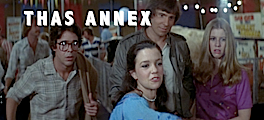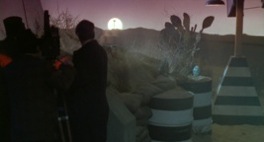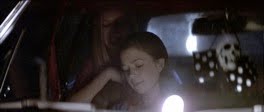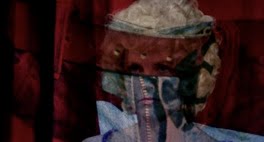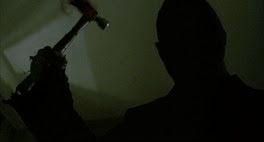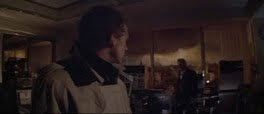
#1 - The Spatial Economy / Spatial System - "If Mohamed won't come to the mountain, then the mountain will have to come to him!"
"The economy of the repetitive angles... in their simplicity and their insistence they create the material system (the economy) of the scene's spatial and emotional triangulations. Simplicity, but in service of fastidiousness."
The above quote references a sequence from Hooper's "Dance of the Dead," and so the specifics of "repetitive angles" and "triangulations" apply mostly to the "Dance of the Dead" sequence and its multiple-character floor plan (which treated changing spatial relationships with the same fastidious close-ups), and can be ignored in regards to the following post. What I wish to carry over is the idea of "economy" and "material system" - meaning a notion that a scene's currency is its shots that circulate and pay off in a closed system of exchange and recurrence (in other words, a fancy framework in which to talk about structure) - while "simplicity" can also be lightly regarded (Hooper generally finds his intricacy through a simplicity), but "fastidiousness" disregarded: that particular word seems much too suggestive of constraint to appropriately describe the zealous, ornamented design of this rather remarkable scene from Spontaneous Combustion.
These first large images will be an initial compendium of the scene's spaces, capturing each (or at least a representative helping) of the "spatial/movement phases" of the scene. Then, following that, the entirety of the scene will be shown in caps.


This is a scene that immediately follows the scene before it.
No, I'm not being obtusely flowery about the unknowable nature of scenes following previous scenes. I mean it literally, in that it continues on from the scene prior. They are continuous in time, yet each constitutes its own remarkable set piece. The scene before this one depicted Sam's (Brad Dourif) drive home, and this scene shows Sam arriving inside his home. The car drive scene is a lovingly filmed ride-along with Brad Dourif's character as he absorbs a number of different sensory cues going on around him: he listens to a radio program of particular interest to him, notices a letter taped to the back of the lid of a birthday present (sitting beside him on the passenger's seat), and he gazes outside at the looming presence of electrical transmission lines. The scene inside his home is a rapt continuation of this minute psychological depiction (and so is the entire film, which is essentially a minute record of this worst day of days): he runs to his radio and turns it on to the same radio station, then, as he takes or makes telephone calls - which prove consistently disappointing, being either unexpected or unreceived - he inspects the card contained inside his present. All the while, he is aurally cued in to both the radio show as well as a conversation on the phone, both of which convene within him dual feelings and responses: the radio show (a spiritualist huckster, Dr. Parsons, using his powers to contact the spirit of an associate of Sam's who died the night before in an unexplained fire) that he both feels contempt for (he is not an innate believer like his New Age girlfriend Lisa, who is a loyal subscriber to Dr. Parsons) and, contradictorily, deep inside, still wishes would bring some sense to the strange, uncanny occurrences happening of late; and the sweet old man phoning him - nuclear mogul Lou Olander, who raised him, and whom he appreciates dearly, but represents a controlled, precarious old life he wishes to slowly extricate himself from (Lou is the father of Sam's cheating ex-wife, who had an affair with the family doctor, who himself is a close business associate of the old man)... Spontaneous Combustion is a film of resonant, symbolic drama such as this, so carefully and tenderly formulated, it practically resounds in how it reflects the film's themes of unfairness, conspiracy, control, relations, burdened history, and the sad banality and inadvertence of much of these ills. What more banal than a trainwreck marriage and ice-cold infidelity, and how remarkable is their use to mirror a world of equally banal government conspiracy, committed historical atrocity, and passed-down familial burden? [Spontaneous Combustion, quite possibly a failed film, but what a brilliant one.]

Perfectly in line with Hooper's attraction to symphonic narratives that minutely chronicle the experiences of characters over a literal (or abstracted) approximation of real (or just subdued) time, here is a paired sequence that perfectly stack on top of one another, comment on one another, join together as symphonic movements in this aspiring sonata of a film, about a man and his heavy history (or, the country and its nuclear burden... the world, a filmmaker, and its/his uncertainty about our technological destiny...).
Treating emotions and actions with the tenderest regard of a director completely in tune with the symphonic continuities of his narrative piece, this scene is a remarkable layering of received sounds, received images, and an acute editing that deftly accounts for the gentle cacophony of aural and visual information that Sam is taking in (though he is unwitting to the magnitude of that which is slowly being foreshadowed to him). This scene is actually a very deliberate piece of sound design...
... in addition to being -- what typically is my only concern -- a deliberate piece of visual design. And it's, of course, as I've already gone on about (in describing his feelings towards the two things he interacts with in this scene - the spiritualist on the radio and father figure Lou Olander on the phone), a remarkable piece of layered dramatic/narrative meaning.
This is a scene that, with the modest genteelness of Hooper's entire artistic enterprise, with delicacy buttressing intricacy, quietude lofting up an inner complexity, hints at the remarkable film around it. Spontaneous Combustion is designed to unfold with this patience and tenderest narrative that imbues with a camera's gentle attentiveness the states of minute, temporal place that the characters are found in - a place of steadily trickling emotional and psychological burden. Spontaneous Combustion is a film of intimacy and empathy, where Hooper's sensitive work does not merely make visceral nor even simply express the emotions of his characters, but, in the discipline and rigor of its ideas of complete attentiveness and acute temporality (among others), somehow transforms mere filmmaking into an art of largesse, gifted towards a characters and story. Hooper constantly proves himself the most feeling of filmmakers.
This scene is one of spaces, predetermined movement (in a film about a predetermined life - of a man's destructiveness beyond free will), and the signals across "the ether fuzz" (to quote that 1986 Hooper sequel; I, of course, refer to telephones and radios) that suggest space longing to be traversed and communication longing to happen, but instead proving exploited by fraud spiritualists or ineffective to bring together star-crossed parties.

Each
picture in this segment of this post is another stepping stone in the scene's structural rendering
of the space: two divisions of a main living room, divided by an archway, the telephone on one side of the half-wall partition, the
radio in the other...
The traveling is a main ingredient of this scene - Sam's traveling, that is, between the radio and the telephone. The camera never follows him past the threshold of the two areas; instead, it seems to limit itself to a barrier on one side of the room, which is revealed to be the whereabouts of the telephone -- but the telephone is never actually shown in the wide shot, and only exists as a disembodied thing, with only chord and receiver held in Brad Dourif's ear acting as ensurer of its existence (also, one single objectified insert shot - our only glimpse of the magical telecommunicating device).
That is just the primary "master cam," markedly analytical in its sense of restriction and observational function. In the background lies the tabletop with the radio, and the diagonal expanse created between foreground (unseen) tabletop and background radio tabletop becomes the precise vector Hooper plays with throughout the mise en scene. Sam travels to the far side of the room on two separate occasions, first to turn on the radio, then to turn up the radio (and switch on an accompanying lamp), and only then does the camera jump - in two structural mirrored shots - to this tabletop where rests the totemic fascinations of a radio and a lamp. This second camera-eye can be designated the "far side cam." It is essentially an insert shot, although also a dynamic one: on both occasions, it begins on the altar of modern appliances, then pans up to Sam's face... and although moving, they serve only to limit or restrict perspective even further. They are at the same diagonal angle as the wide, and clearly serve only to fix us even further into the diagonal line of Sam's movement.

And so we've set up part of the spatial economy (the material
system, where exchanged is the monetary currency that is repetitive and reflexive spatial shots) of this scene -- not revealed in this initial look at the scene is Hooper's use of impressionistic insert shots of the mysterious birthday present which Sam inspects simultaneously as he fusses with the radio and fields the telephone call.
The dialectical nature of the scene's formal design is clear: this is a scene about the relationship between two
spaces, two devices, and Sam's back-and-forth between them, as they both
represent new information to him during this day where information (and misinformation), pulling him to and fro, is the exacerbating factor in his eventual death march. Yet the profundity comes from this information not being relayed to him by polar forces so demarcated, or black-and-white, as to be anything but banally grey, as was suggested above when talking about the radio psychic Dr. Parsons and the adoptive father Lou Olander, two deeply ambivalent figures in Sam's life. The radio mystic presents not just the exploitation of our deepest wishes in the divine, but also those very same wishes (he reminds us of our want of these wishes, even in his falsehood) - which Sam dismisses and which the film's other central character - the naive but represented as wholly good Lisa - embraces. Thus, Dr. Parsons represents both pernicious fraud, Sam's ingrained cynicism, and an integral facet of the film's one pure good, Lisa. (Always the sign of the humanist filmmaker, or the grand melodrama: when insufferable naivety is represented as the purest good. Romantically involved Sam and Lisa are dramatically contrasted: he is a sharp cynic capable of great anger; she wantonly subscribes to spiritualists and homeopaths and doesn't have a distrusting bone in her body. This pays off in the film's finale, that, while botched, communicates essentially enough the story's fable-like conclusion: a miracle beyond science does occur when in flagrante Sam [I'm being cheeky - he has literally just burned up in a pillar of fire] goes to the burning Lisa and, through his pure love, "takes away her fire" - divine reckoning in a film previously about divine wishes that are false delusions ["I made the sun rise twice that day!"] or never pay off ["No one's watching anymore"]. Spontaneous Combustion's remarkable, thoughtful construction insinuates itself again... "one of the most richly conceived works" as much as it is something unrealized.)
Dr. Parsons shows Sam tuning into a program he earlier had no kind words for. The telephone conversation with Lou brims with the warmth of the past, but Brad Dourif expertly embodies Sam's current feelings about his relationship with Lou, as being something on the periphery of his life now (though even the witchy ex-wife - Lou's own daughter - admits to him: "He asks about you all the time," as if the old man's preference is clear). "Of course I'll have lunch with you," Sam tells him - then hangs up a second later. In both cases, Sam is a duality, just as the space is a duality and the scene is made up of dualities.
It is an integral, culminate point: the fact that Hooper's scene craft constantly
delimits itself into something academic... and what a deeply sophisticated delimiting it often is. This scene is a brazenly unbrazen display of scholastic care and bookish, instructive reason: this shot will follow this shot for the reason of because, and this shot will directly feed into this shot because so forth and so forth, and this entire scene will be structured as a doubling repetition in order for, and the rhythms will be dictated by the actions, which are already recited within the edits already dictated by the camera, etc. etc...
How he manages to keep deeply working into the fabric of so many of his films these often astoundingly subtle frameworks of formal construct, tied to narratives that drink deep from a well of rich subtextual waters, is perhaps my biggest marvel: one need only look at this film and The Funhouse to notice the pattern of tapestry-like poetical and allegorical thought put into the stories and their cinematic assemblage, and one can easily continue on from there to Night Terrors, The Mangler, Lifeforce, The Dark, etc.
A recurring formal proclivity of Hooper's comes in the form of his use of architecture to create concerted geometries and lines of perspective around his characters and characters' heads (he often uses bayed, segmented walls and the looming of angular ceilings), architecture often seeming to come to life in the elaborate ways he has the camera interact with shifting relationships between actors and scenery - principles of horizon, foreshortening, parallax, and graphical flattening coming into consideration in grand ways.
Here he uses a tangle of molding that seems to branch out like a system of wires, or a map of highways, and that backdrops Brad Dourif's character as either a flattened diagram of circuitry, or a fanning horizon of wood-panel cross hatching. In either case, Hooper uses them to emphasize a directionality in regards to Sam: for instance, the forward-shooting guiding lines that seem to push outward along Sam's gaze in the still below, or the beams of constraint that fan over Sam and into the distance in the low-angle shot of Sam on the phone a few stills above.


And now, the entirety of the scene. It is the only way to do justice, as Hooper's approach to filmmaking is fine and precious:
#1 - The Spatial Economy / Spatial System - "If Mohamed won't come to the mountain, then the mountain will have to come to him!"
#1 - The Spatial Economy / Spatial System - "If Mohamed won't come to the mountain, then the mountain will have to come to him!"

-
-
The foreground table is unseen (the camera position
comes to represent the tabletop).
The radio is deep in the frame.

RADIO VOICE: "Do you hold the key? Just the other side of that mystical door..."






(PHONE RINGS)
RADIO VOICE (faint): "... to the chamber at the top of your mind, is an impossible treasure hunt..."
The master shot moves: cued to Sam's return, it curves along Sam's path,
meeting him, like an impartial romantic, at the phone.

"... worth far more than gold,
or fame,
or money..."





He reaches out of the frame to the as-of-this-point non-existing phone. Hooper's angular ideas towards the angular use of the frame - what it includes and does not include (The Funhouse has great examples of this), and subsequently how this makes his frames comment on each other and interact - is such rich, esoteric personal form.
(And now: bringing to body the telephone...)





"Hi."
LOU: "Hello, Sam?"
(He expected it to be Lisa, but it is instead Lou.)
SAM: "Oh! Lou!"






LOU: "Are you alright?"

SAM: "Yeah, of course I am!"

LOU: "Rachel told me you burnt your finger! Is it serious?"





SAM: "How could Rach---? No, Lou... it's nothing. It's fine."





LOU: "Are you sure?"
 SAM: (incredulous) "I'm positive!"
SAM: (incredulous) "I'm positive!"LOU: (as if speaking in turn) "Oh! Sam, I'd like John Marsh to take a look at it."
SAM: (annoyed) "Lou. I saw him once today, that's enough." (John Marsh is the family doctor/ex-wife's method of cuckoldry.)
(kindly again) "Don't worry, I'm fine!"



LOU: "Now don't be upset!"

(On the radio) DR. PARSONS: "I will now attempt to communicate..."
LOU: "You know, you're very special to me..."
"... with the very recently departed spirit of Rachel Whitaker."




He turns back away from the radio, still needing to inspect the letter -- his attentions made intricate, crisscrossing.





LOU: "Hey, when am I going to see you?"







LOU:
(laughs)

"If Mohamed won't come to the mountain then the
mountain will have to come to him!"
mountain will have to come to him!"






LOU: "Will you have lunch with me on Thursday?"

SAM: "Of course I will. I'd love to."
LOU: "Alright, son... then, I'll--- I'll see you..."
SAM: (abruptly) "OK, bye Lou..."
(He hangs up. Meanwhile, in the background, Dr. Parsons grunts in heavy-handed psychic exertion.)





DR. PARSONS: "Danger... it's... very dangerous."







DR. PARSONS: "I--- I ca----..."
The camera once again jumps to the radio tabletop as Sam switches on the lamp, and, upon Sam's touching the radio dial (this time to raise the volume), once again it pans up his arm to his face. Essentially a structural repetition of that earlier shot.








DR. PARSONS: "Oh, I can't seem to reach the spirit at this time!"

"Perhaps... she has already been reincarnated..."
(Sam closes his eyes in annoyance at the thinly veiled maneuvering.)




"Or perhaps she is in another galaxy, or dimension..."





"Very difficult... very--- I think she must be hiding."
"A real trickster, this one."







DR. PARSONS: "Well... I can see we're coming up on the hour and it's time for the news. I certainly hope..."



(he goes to the phone and dials an outgoing call)
"... that all of my goods listeners will stay tuned and rejoin our discussion---"
LISA'S VOICE: "Hi, this is Lisa..."
"... I can't take your call right now but please leave a message after the beep."




An introduced space through transmitted signal. An evocative, strangely beautiful image and moment: the dear and loved one absent, not existing, yet through this electronic means, assures him who calls that she is always present for him. A person represented by electrical box. A personality represented by a carefully arranged tabletop (merely flashed before us, as the camera is instantly dollying in to just the answering machine). A lyrical glimpse of the personality, this serving as the first time we ever see her apartment (it will be used to even more lyrical ends in the film's finale). Her voice is a shocking sweetness in a time when unease conquers, and it is juxtaposed with the idleness of the plastic aesthetic objects that surround the box that somehow contains the human voice. The magnetic inscription, an ethereal comfort. Technology is given a fair shake: the film mostly demonizes our technological future, and the machinery and neon seen here on this tabletop is not exactly comforting, but it carries a personality and imbued preciousness, for this is the apartment of the good-hearted, neophyte mystic Lisa: her "electric decor" is of her choosing, and its over-pronounced futurity does sweetly recall her naivete, her sincere New Age artlessness, or an eye for beauty in even its most misplaced state (the neon or opaline pastels of this shot easily overcome the general chilliness or garishness). It suggests the 20th century's achievements are indeed actually seen as a new mystical element by many, one that opens the door for new approaches to spiritual and natural awareness. After all, atomic nature is still nature, and nature is where all mysticism grows out from.



SAM (through the answering machine): "Hi sweetheart, it's me, the---"

"---world's greatest actor. Where are you? I thought we were getting together. Please give me a phone call, I have to talk to you."





DR. PARSONS (faint): "... as always, we will remain on the air and ready to _____ your phone calls until 8:30..."





(THE DINGING OF SAM'S ANTIQUE POCKET WATCH.)
A recurring shot throughout the film: a close-up of the pocket watch.
RADIO VOICE: "WKTO Newstime, six o' clock. In local news, the Trinidad Beach power plant finally comes online tonight at midnight - only six hours from now."


All the insert shots of the items Sam looks at and inspects are given dreamy close-ups, utilizing expressionistic lighting or soft focus backgrounds. He stands in three positions while looking at three items: first the present while standing near the phone, then the letter when he has shifted to his right (he shifts in order to turn on the lamp near the phone), then the pocket watch. Accordingly, Hooper shows us three different backgrounds for each item. Looking at the present box, it is entirely literal: Sam looks upon the tabletop where the present sits... but the lighting is moody and romantic, with a glowing, dappled white light to evoke window-passed sun. Examining the letter, we are suddenly in an impressionistic anti-space of shafts of house colors and shadow. For the watch, another texture - close to that of the letter, but new - is used.
The remarkable utilization of the room's molding as jagged geometric formations, beginning in the last close-up of Sam above, is enhanced by the use of the similar-at-first-glance but actually completely different shot seen below. The below is simply a variation - same subject(s), same angle, but pulled out further, replacing the use of the windows' molding (as parallel "wings" on either side of Sam) in the previous shot and now using the half-wall divider as a sort of cross-like brace shaped to Sam's own body and posture.
The use of a subtle variation for subtle effect would have been uncanny sophistication enough, but Hooper enhances it further by allowing this variation shot to be the segue into the scene's next musical section: Sam's business with the radio and the telephone is now over, and Sam crosses over into the living room before him, the camera tracking out and revealing this new space alongside his full entrance into it. Choreographed camera motion cued, and again, much vorticular hubbub is made of Sam's going to another lamp and turning it on, becoming the third lamp turned on in this scene -- to inaugurate the third space of this scene. Hooper's fascination with musicalized movement (he has created a rhyme between the scene's three spaces - one lamp by each the radio, the telephone, the fireplace) becomes tied to symbolic action of turning on lamps (conceivably some latent humanist fascination Hooper has with the notion of illumination; see Eaten Alive for more of this peculiar attention given to lamps) (or Godard).
This "tracking out and revealing" brings about the third phase of Hooper and his camera's "musicalizing of molding" - now the molding seems to come alive over and around Sam (through the magic of lens and parallax), representing the constricting unease that has come over him, seeping in even in his own house.

RADIO VOICE: "A small group of peaceful but determined demonstrators
have been keeping vigil for more than five days in front of the main gates
of the super power facility, but so far there have been no arrests."













RADIO ANNOUNCER: "In federal studies of the Duquesne nuclear power plant, it was found that 28 kinds of fish were killed..."























